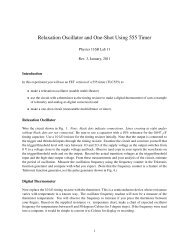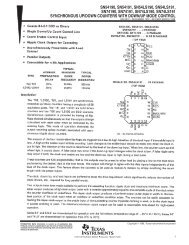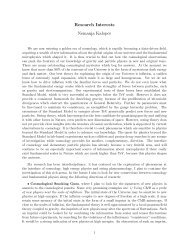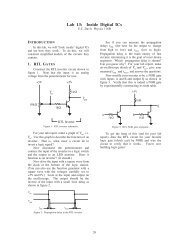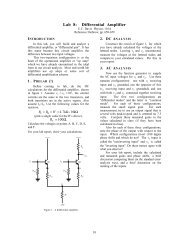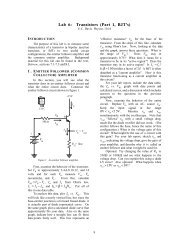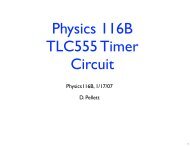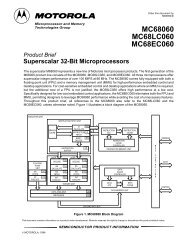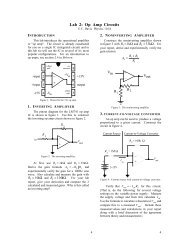Thermo
Thermo
Thermo
Create successful ePaper yourself
Turn your PDF publications into a flip-book with our unique Google optimized e-Paper software.
<strong>Thermo</strong>dynamics and Statistical Mechanics<br />
1 General Definitions and Equations<br />
• First Law of <strong>Thermo</strong>dynamics: Heat Q is a form of energy, and energy is conserved.<br />
– dU = dQ − dW<br />
• Second Law of <strong>Thermo</strong>dynamics: The entropy S of a system must increase.<br />
– ∆S ≥ 0<br />
• Third Law of <strong>Thermo</strong>dynamics: For a system with a nondegenerate ground state<br />
S → 0 as T → 0.<br />
– lim<br />
T →0<br />
S = k B ln Ω 0 , where Ω 0 is the degeneracy of the ground state<br />
• A system is equally likely to be in any of the quantum states accessible to it.<br />
• Equipartition theorem: each “degree of freedom” of a particle contributes 1 2 k BT to<br />
its thermal average energy<br />
– Any quadratic term in the energy counts as a “degree of freedom”<br />
– E.g. monoatomic: 3 translational, 0 rotational, 0 vibrational → 〈E〉 = 3 2 kT<br />
– E.g. diatomic: 3 translational, 2 rotational, 0 vibrational (2 at high T) →<br />
〈E〉 = 5 2 kT ( 7<br />
2 kT at high T )<br />
• Binomial Distribution: P (n, N − n) =<br />
( ) N N!<br />
– =<br />
n n!(N − n)!<br />
N∑<br />
– Normalization: P (n, N − n) = 1<br />
– Mean: 〈n〉 =<br />
n=0<br />
N∑<br />
nP (n, N − n) = Np<br />
n=0<br />
– Variance: 〈 n 2〉 − 〈n〉 2 =<br />
( N<br />
n<br />
)<br />
p n (1 − p) N−n<br />
N∑<br />
n 2 P (n, N − n) − (Np) 2 = Np(1 − p)<br />
n=0<br />
1
• Gaussian Distribution: P (x) =<br />
– Normalization:<br />
– Mean: 〈x〉 =<br />
∫ ∞<br />
−∞<br />
∫ ∞<br />
−∞<br />
– Variance 〈 (x − µ) 2〉 =<br />
– P (a < x < b) =<br />
P (x) dx = 1<br />
xP (x) dx = µ<br />
∫ b<br />
a<br />
∫ ∞<br />
−∞<br />
P (x) dx<br />
( )<br />
1<br />
√ exp (x − µ)2<br />
−<br />
2πσ<br />
2 2σ 2<br />
(x − µ) 2 P (x) dx = σ 2<br />
• Heat capacity, c: Q = C∆T , C = mc, where c is the specific heat capacity<br />
• Molar heat capacity, C: Q = nC∆T , where n is the number of moles<br />
• Latent heat of fusion (Q to make melt): Q = mL f<br />
• Latent heat of vaporization (Q to vaporize): Q = mL v<br />
• Ideal Gas Law: P V = nRT = Nk B T<br />
• For an ideal gas, C p = C V + R, where C V =<br />
• Adiomatic index: γ = C P<br />
C V<br />
( ) ∂Q<br />
, C P =<br />
∂T<br />
V<br />
( ) ∂Q<br />
∂T<br />
P<br />
– γ = 5 3 for monoatomic gases, γ = 7 5<br />
for diatomic gases<br />
• Stirling’s Approximation: ln(n!) ≈ n ln(n) − n, for n >> 1<br />
2 Energy equations<br />
• <strong>Thermo</strong>dynamic Identity: dE = T dS − P dV + µdN<br />
• Helmholtz Free Energy: A = E − T S ⇒ dA = −P dV − SdT + µdN<br />
• Enthalpy: H = E + P V → dH = T dS + µdN + V dP<br />
• Gibbs free energy: G = A + P V = E + P V − T S → dG = V dP − SdT + µdN<br />
( )<br />
∂ ∂Φ<br />
• Maxwell relations:<br />
= ∂ ( ) ∂Φ<br />
∂x j ∂x i ∂x i ∂x j<br />
2
3 <strong>Thermo</strong>dynamic Processes<br />
∫ dQ<br />
• Reversible process: happens very slowly, ∆S =<br />
T<br />
• Irreversible process: happens very suddenly<br />
∫<br />
• Work: W = P dV<br />
• Isothermal: T held constant<br />
– dU = 0 → dQ = dW<br />
• Isochoric: V held constant<br />
– W = 0 → dU = dQ<br />
• Isobaric: P held constant<br />
– W = P ∆V<br />
• Isoentropic: S held constant<br />
• Adiabatic: dQ = 0<br />
– dU = −dW<br />
– Also isoentropic if reversible<br />
– P V γ = constant<br />
• Heat engine thermal efficiency: e = 1 + Q C<br />
Q H<br />
• Refridgerator coefficient of performance: k =<br />
• Carnot cycle thermal efficiency (ideal): e = 1 − T C<br />
T H<br />
|Q C |<br />
|Q H | − |Q C |<br />
• Carnor refridgerator coefficient of performance: k =<br />
T C<br />
T H − T C<br />
4 Microcanonical Ensemble<br />
• S = k B ln Ω, Ω is number of microstates accessible<br />
3
5 Canonical Ensemble<br />
• Partition function: Z = ∑ s<br />
e −βεs , where β = 1<br />
k B T<br />
• With degeneracies: Z = ∑ s<br />
g s e −βεs , where g s is the degeneracy of the s state<br />
• P (ε s ) = e−εs/k BT<br />
Z<br />
• 〈ε〉 = 1 ∑<br />
ε s e −βεs = − d ln Z<br />
Z<br />
dβ<br />
• A = −k B T ln Z<br />
s<br />
• S = ∂<br />
∂T (k BT ln Z) = − ∂A<br />
∂T<br />
• For N indistinguishable particles, Z N = ZN<br />
N!<br />
6 Grand Canonical Ensemble<br />
• Chemical potential µ = −T ∂S<br />
∣<br />
∂N<br />
• Grand partition fucntion: Z =<br />
• P (N, ε) = 1 Z exp (<br />
− ε s(n) − µN<br />
k B T<br />
• 〈N〉 = k B T ∂ ln Z<br />
∂µ<br />
7 Blackbody Radiation<br />
∣<br />
E<br />
• Stephan Boltzmann Law: Φ = σT 4<br />
– Φ is energy flux of star<br />
∞∑ ∑<br />
N=0 s(N)<br />
– T is the temperature of the star<br />
)<br />
(<br />
exp − ε )<br />
s(n) − µN<br />
k B T<br />
– σ = 5.67 × 10 −8 JK −4 m −2 s −1 is Stephan-Boltzmann constant<br />
4
• Planck radiation Law: u ω =<br />
<br />
π 2 c 3 ω 3<br />
e −βω − 1<br />
– u ω is spectral density, energy per unit volume per unit frequency<br />
• Wein’s Law<br />
– λ peak = 2.9 × 10−3 mK<br />
T<br />
8 Particle Distributions<br />
• Maxwell-Boltzmann (for classical, distinguishable particles): n(ε) = e −β(ε−µ)<br />
• Fermi-Dirac (for identical fermions): n(ε) =<br />
– As T → 0, n(ε) →<br />
{<br />
1 if ε < µ(0)<br />
0 if ε > µ(0)<br />
1<br />
e β(ε−µ) + 1<br />
– Fermi energy E F = µ(0), all states filled below E F no states filled above E F<br />
• Bose-Einstein (for identical bosons): n(ε) =<br />
1<br />
e β(ε−µ) − 1<br />
5



